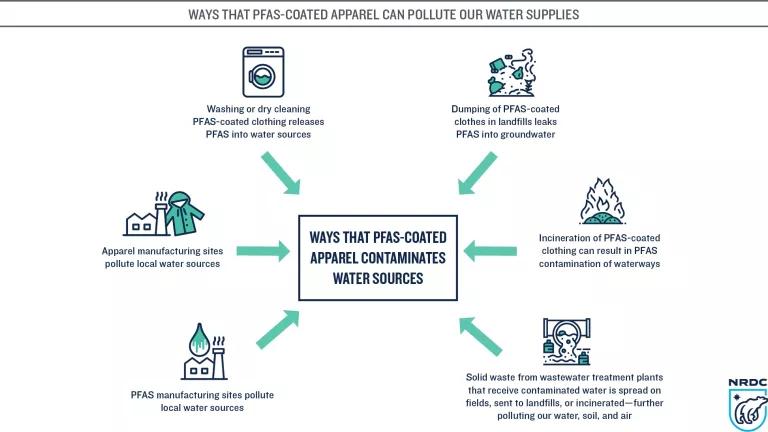New Analysis Shows Widespread PFAS Contamination of Tap Water in CA
Estimate of Californians with PFAS in drinking water jumps to 25 million—highlights need for proposed bill SB 903 to end unnecessary use of forever chemicals.

Brian Maranan Pineda for NRDC
Toxic “forever” PFAS chemicals are a serious environmental health issue in California and across the globe, linked to numerous health harms. California has been a leader in addressing PFAS, including banning PFAS use in multiple products (such as fire-fighting foam and textiles). Yet PFAS continue to be used in hundreds of different consumer and industrial products and our new analysis, released today, shows drinking water sources serving up to 25 million Californians are or have been contaminated with PFAS.
A bill by Senator Nancy Skinner, also introduced today, proposes a much needed comprehensive, efficient, and health-protective approach to phasing out the use of these highly problematic chemicals. Such preventative legislation will be key to helping to address the PFAS crisis. We also need to tackle current contamination by setting drinking water standards for PFAS.
What are PFAS
PFAS are a class of thousands of chemicals that are used because they provide temperature resistance and nonstick, stain proof, and greaseproof properties to a variety of consumer and industrial products. Due to their widespread use and release into the environment, virtually all of us have one or more PFAS in our blood.
This is alarming because exposure to PFAS is associated with a range of harmful health effects including kidney and testicular cancer, high cholesterol, changes in hormone levels, and harmful effects on the liver, kidneys, and immune, nervous, and reproductive systems.
New data on widespread contamination of California drinking water
California has been monitoring drinking water sources for PFAS, including those near potential contamination sites like landfills, wastewater treatment plant discharge points, oil and gas facilities, metal plating facilities, and airports. In 2021, NRDC published a report that analyzed the initial data from this monitoring program, with a particular focus on data related to drinking water in overburdened communities. These investigations revealed that PFAS pollution in California is widespread throughout the state, but more prevalent in communities already overburdened by multiple sources of pollution and by other factors that make them more sensitive to pollution, putting those vulnerable communities at greater risk of harm from PFAS exposure.
Today, we updated our analysis to include testing results from 2019 to 2023. New data show that PFAS have been found in water systems serving up to 25.4 million Californians (up from an estimated 16 million in our original analysis). Importantly, PFAS pollution continues to be more prevalent in state-identified disadvantaged communities, with up to 8.9 million Californians in these communities potentially impacted. The current data cover approximately 28.7 million Californians (73 percent of the population). As testing continues, the number of Californians potentially affected by PFAS-contaminated water will likely grow. This underscores that we cannot keep adding to the already immense problem and must curb unnecessary uses.
Reducing sources of PFAS pollution
Many uses of PFAS are unnecessary and can be stopped immediately. California has been a leader in addressing such uses, having already passed laws to ban the use of PFAS in firefighting foam, food packaging, juvenile products, textiles, and cosmetics. However, with over 200 different PFAS use categories cataloged to-date, a more efficient approach is needed to reduce sources of PFAS pollution.
PFAS pose too much harm to warrant their continued unchecked and often unnecessary use. That is why Senator Nancy Skinner, with the support of NRDC, Breast Cancer Prevention Partners, California Association of Sanitation Agencies, Clean Water Action, and Environmental Working Group, today introduced a comprehensive, science-based approach to phasing out unnecessary uses of PFAS. Starting January 1, 2030, Senate Bill 903, also known as the Ending Forever Chemicals Act, will prohibit the sale and distribution in California of products with avoidable uses of PFAS. The bill is based on the essential use approach, a framework for which was developed in this peer reviewed scientific paper and succinctly explained in this issue brief.
Ending Forever Chemicals Act
Senator Skinner's bill aims to end unnecessary use of PFAS by 2030 while acknowledging that some uses of PFAS may still be unavoidable and will need more time to transition away from PFAS. Under the bill, manufacturers would be able to petition the Department of Toxic Substance Control for a determination that a use of PFAS is “currently unavoidable” to receive a time-limited exemption to the 2030 phase out.
A PFAS use is currently unavoidable only if all of the following are true:
(1) there are no safer alternatives to PFAS that are reasonably available,
(2) the function provided by PFAS in the product is necessary for the product to work, and
(3) the use of PFAS in the product is critical for health, safety, or the functioning of society.
Manufacturers may reapply for a currently unavoidable determination every five years until their PFAS use is avoidable, but must show efforts towards developing and transitioning towards safer alternatives. Importantly, safer alternatives are not limited to drop-in chemical replacements for PFAS, but can include materials, processes, designs, or products that achieve the desired result, such as fibers that are inherently stain resistant instead of a chemical-based stain-resistant spray. If the Department is aware (or made aware through public petition) of PFAS uses that are avoidable before 2030, the Department may act sooner to ban these uses ahead of the 2030 timeline.
Putting an end to toxic forever chemicals
The new data analysis we released today underscores the need for comprehensive action. Californians deserve clean water and safe products. This bill is critical for achieving both. By reducing the use of PFAS in consumer and industrial products, this bill will reduce the amount of PFAS released into the environment during product manufacturing, use, and disposal. SB 903 is a solution that matches the magnitude of the PFAS crisis. We applaud Senator Skinner’s leadership in protecting Californian’s environment and health.
Additional actions also needed to protect drinking water from PFAS
Senator Skinner’s preventative legislation will be a crucial step towards preventing further PFAS contamination of our drinking water. However, separate from this legislation, we also need to have enforceable drinking water standards to protect the 25 million or more Californians, and tens of millions of people across the United States who already have PFAS in their tap water. The U.S. Environmental Protection Agency (EPA) proposed important standards for six PFAS in March 2023, but the final standards have been under review by the White House Office of Management and Budget for two months, and need to be finalized as soon as possible. In addition to the great job that California is doing to investigate PFAS contamination, California should continue to work towards setting comprehensive drinking water standards to cover the entire class PFAS, so residents of the Golden State are protected from the full array of thousands of PFAS that could find their way into our tap water.




